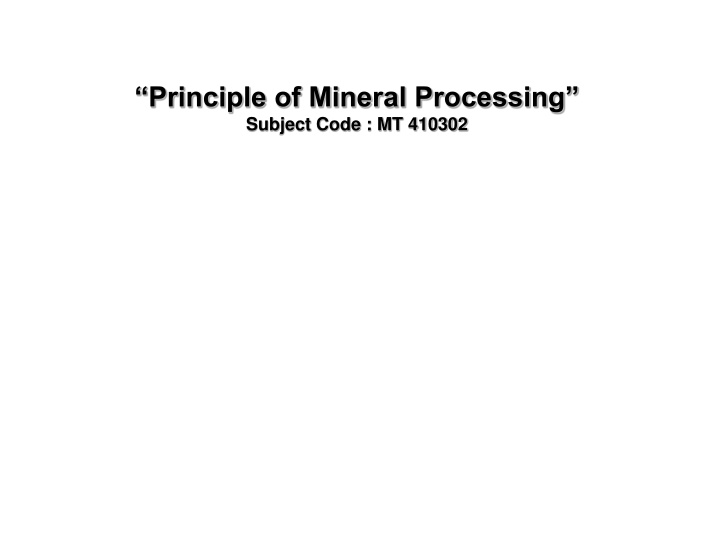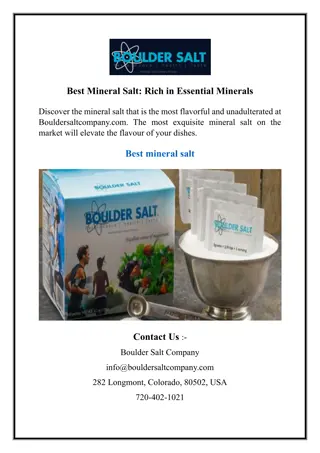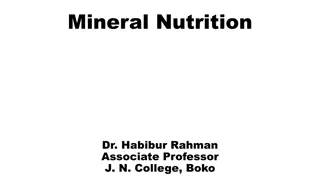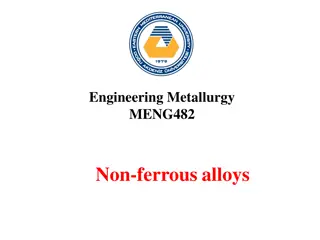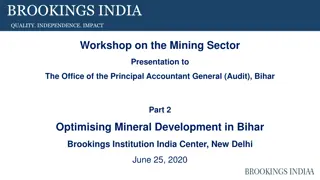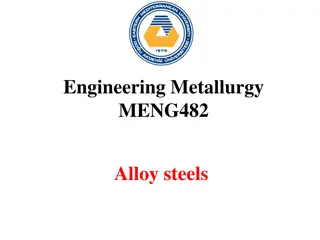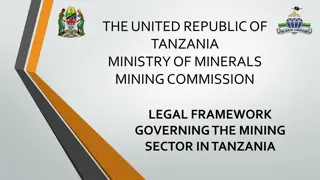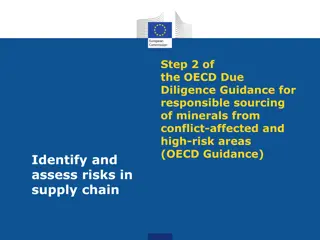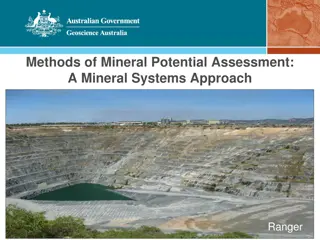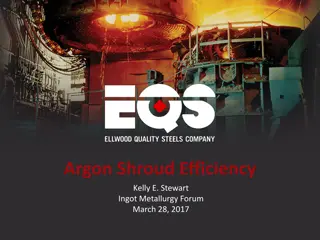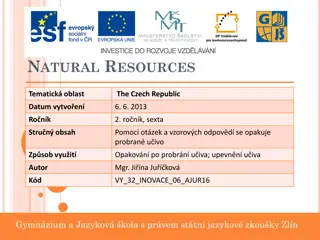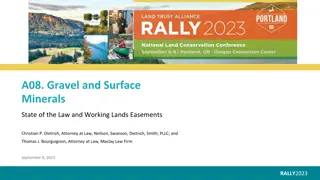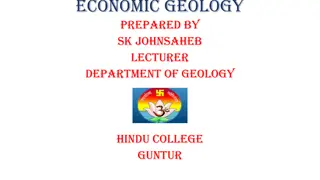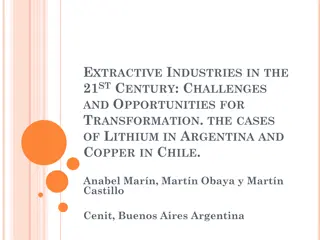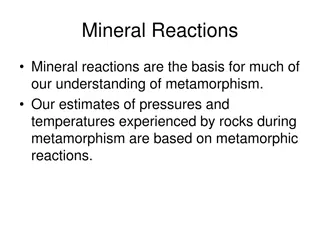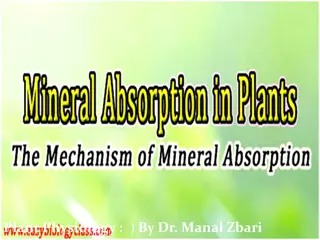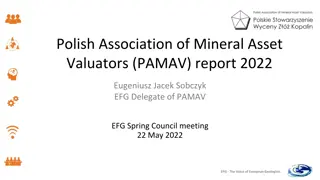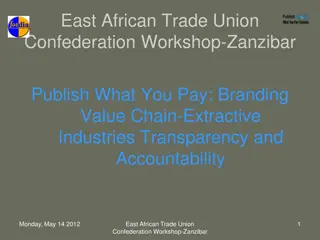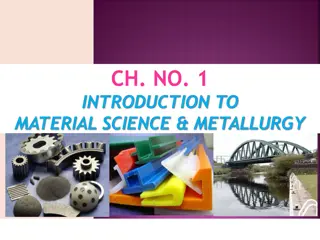Principles of Mineral Processing in Extractive Metallurgy
Introduction to the principles of mineral processing focusing on the scope, physical characteristics, and economics of ore processing. The syllabus covers terminology, mineral resources in India, and the processing of industrial minerals like Haematite, Galena, and Chalcopyrite. Learn about ore deposits, grades, economically important metals, and the economic and technical justification of ore dressing processes.
Download Presentation

Please find below an Image/Link to download the presentation.
The content on the website is provided AS IS for your information and personal use only. It may not be sold, licensed, or shared on other websites without obtaining consent from the author.If you encounter any issues during the download, it is possible that the publisher has removed the file from their server.
You are allowed to download the files provided on this website for personal or commercial use, subject to the condition that they are used lawfully. All files are the property of their respective owners.
The content on the website is provided AS IS for your information and personal use only. It may not be sold, licensed, or shared on other websites without obtaining consent from the author.
E N D
Presentation Transcript
Principle of Mineral Processing Subject Code : MT 410302
Principle of Mineral Processing - Syllabus Unit 1 Introduction and scope of mineral processing in extractive metallurgy, Mineral resources in India, Physical characteristics exploited in mineral processing, Terminology in mineral processing Physical and chemical characteristics of industrial minerals such as Haematite, Magnetite, Galena, Chalcopyrite, Azurite, Monazite, Cassiterite, Chromite, Bauxite and Ilmenite; Economics of ore processing. Selectivity index.
Introduction Mineral Naturally occuring chemical compound having definite chemical composition & crystal structure. Ore Natural aggregation of minerals from which a metal or metallic compound can be recovered. Mineral Processing of raw minerals : Marketable products without destroying physical & chemical identity of minerals Chalcopyrite Galena ( PbS)
Introduction Ore Deposit An occurrence of minerals or metals in sufficiently high concentration to be profitable to mine and process using current technology and under current economic conditions. Ore Grade Ore grade is the concentration of economic mineral or metal in an ore deposit. Weight percentage (base metals) Grams/tonne or oz/ton (precious metals) 5
Economically Important Metals Typical Grades of Ore Deposits Typical Grade (% by weight) 30 53 0.5-4 1 4 0.3 5 0.01 0.0001-0.001 Metal Aluminum Iron Copper Nickel Zinc Uranium Lead Silver Gold 7
Introduction Economic & Technical justification of ore dressing - Less expensive than hydro & pyro process - savings in freight - reduced metal losses in slag - lower smelting cost Scope of mineral dressing process - elimination of a) unwanted chemical species/gangue b) unsuitable particle size Most minerals - Crystalline in nature with crystal structure
Types of minerals Native Form : Cu, Gold , Silver, Bismuth, Diamond Sulphides Chalcopyrite CuFeS2, Galena PbS , Sphalerite ZnS Oxides & Hydroxides : Cuprite Cu2O , Rutile TiO2, Hematite Fe2O3 Carbonates : Calcite CaCO3 , Magnesite MgCO3, Cerussite PbCO3
Types of minerals Halides : Salt NaCl , Fluorite CaF2, Cryolite Na3AlF6 Nitrates : Soda Nitre NaNO3 , Nitre KNO3 Sulphates : Barytes BaSO4 , Anglesite PbSO4, Gypsum CaSO4.2H2O Borates : Borax Na2B4O7.10 H2O
Mineral Resources in India Classification of mineral resources in Indian perspective Surplus Group : Iron ore, barite, bauxite, mica, soapstone, china clay, gypsum, beach sand, sillimanite, ornamental stone, chromite (low grade), dolomite and limestone ( cement grade) Self sufficient Group: Thermal coal, lignite, chromite, pyrite etc. Satisfactory Group : Zinc, magnesite, fireclay, ilmenite sand ( titanium) rutile, sand(titanium)
Properties used for Separation S No Characteristics Techniues Employed 1 Colour /Lustre Hand Sorting ( Sulphur , Graphite -black) 2 Sp Gravity Jigs, Shaking Table ( Gold grains / Quartz sand ) 3 Ferromagnetism Magnetic separators ( Cobalt ore) 4 Conductivity Cu , Gold - conductor , Quartz , Calcite - non conductor 5 Shape Sliding action to remove slate from coal 6 Texture Surface - Galena , Magnetite , Chalcopyrite 7 Chemical reactivity Leaching of ores , Solvent Extraction ( Cu & Co ore) Aerophilic mineral ( Cu sulphide as froth) 8 Surface reactivity
Physical Properties of Minerals Minerals Chemical Components Sp Gravity Colour Hardness mhos scale 5.5-6.5 5.5-6.5 3 3.5-4 3.5-4 5-5.5 6-7 5.5 1-3 5-6 Lustre Magnetism Hametite Magnetite Galena Chalcopyrite CuFeS2 Azurite Monazite Cassiterite Chromite Bauxite Ilmenite Fe2O3 + TiO2 Fe3O4 PbS 4.9-5.3 5.2 7.4-7.6 4.1-4.3 3.8-3.9 4.9-5.3 6.8-7.1 4.3-4.6 Black , Grey , Red.Brown Grayish / Iron black Grey ( light & dark) Brass yellow Deep blue Brown , Green, Yellow, White Brown , Green, Gray, colorless Brown , Black Light yellow & Green Iron Black Metallic Metallic Metallic Metallic Glassy Resinous Adamantine Metallic Vitreous-Pearly Sub metallic On heating strong No On heating No No No weak No weak 2CuCO3.Cu(OH)2 (Ce, La,Th)3(PO4)4 SnO2 FeO.Cr2O3 Al2O3.3H2O+Ti,Si, Fe oxides 2.45 -3.25 FeO.TiO2 4.5-5
Quantitative Measurement Ratio of concentration Wt of conc / wt of Feed Recovery Assay value in Conc. / assay value in feed Selectivity Index Geometrical mean of recoveries & rejections S.I. = ( CPb/TPb*Tg/Cg) Pb-value in conc. - 60.5% & Tailing - 0.2% , Gangue in conc - 12.6% , & Tailing - 94.6% SI = ((60.5/0.2)*(94.6/12.6)) ^1/2 =47.6
Quantitative Measurement Economic Recovery or Efficiency % ratio of actual value of concentrate per ton of ore to the theoretical value of concentrate Example : 130 kg of Pb concentrate / T of ore worth Rs 16000 Theoretically 120 kg pure Galena worth Rs 18000. Actual recovery = (0.13*16000)/(0.12*18000) =96.3% ,
Metal Accounting Uses steady-state accounting of mass flows in a system evaluation of metallurgical testwork comparison of two different mills or circuits process control of an operation plant Properties of the Balance requires samples for assay and weights/flowrates accuracy of the assays used turnaround time of assays 18
Metallurgical Balances The method relies on equations and tables Equations T F 2-Product Formula C F = C + T Ff = Cc + Tt where F = feed tonnage rate or 100% C = concentrate tonnage or weight% T = tailing tonnage or weight% and f, c, t = assay of each respective stream (%, g/t, ppm, etc.) 19
Metallurgical Balances 2-Product Formula Solution C = 100 * (f-t)/(c-t) %Recovery = 100 * c(f-t) /f(c-t) The Metallurgical Balance Table Assay (%) Units Cc %Recovery Cc/f Tt/f Product Weight% C c t Concentrate T Tt 100f Tailing f 100 100 Feed 20
